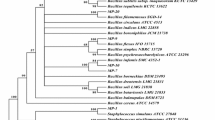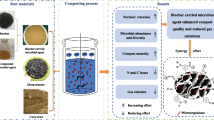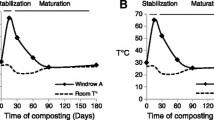Abstract
Community level physiological profiles (CLPPs) have been rarely applied to mushroom compost ecosystem, probably for the lack of standardized methodology. Recently, however CLPPs have been employed as a tool to investigate the degree of maturity of compost (Mondini and Insam, 2005, Compost Science and Utilization, 13(1): 27–33). The potential of CLPPs to detect compost maturity test is considerably significant in that it provides sensitivity and the simplicity of the assay. The aim of this work was to investigate the maturity of casing that comprised of farm yard manure and spent compost and influence of casing type on the behaviour of bacterial community during the growth cycle of mushroom Agaricus bisporus (Lange) Imbach employing standardized inoculum density and effects of different data interpretation based on the kinetics of colour formation. Casing samples of different age were extracted at a particular dilution and then inoculated in 96 well microtitre plates. Optical density (OD) in well was measured at 590 nm every 24 hours for 5 days. Principal component analysis (PCA) was performed by employing OD values at fixed average well colour development (AWCD). PCA of fresh samples showed that classification and ordination of samples according to their age were significant with fixed AWCD.
Similar content being viewed by others
References
Noble R, Fermor TR, Lincoln S, Dobrovin-Pennington A, Evered C, Mead A, Li R (2003) Primordia initiation of mushroom (Agaricus bisporus) strains on axenic casing materials. Mycologia 95(4):620–629
Garland JL (1997) Analysis and interpretation of community-level physiological profiles in microbial ecology. FEMS Microbiol Ecol 24:289–300
Mondini C, Insam H (2003) Community level physiological profiling as a tool to evaluate compost maturity: a kinetic approach. Euro J Soil Biol 39:141–148
Carpenter-Boggs L, Kennedy A, Reganold JP (1998) Use of phospholipids fatty acids and C-source utilization patterns to track microbial community succession in developing compost. Appl Environ Microbiol 64: 4062–4064
Insam H, Feurle J, Rangger A (2001) Community level physiological profiles (Biolog substrate use tests) of environmental samples. In: Akkermans ADL, van Elsas JD, DeBruijn FJ. eds. Molecular Microbial Ecology Manual: Kluwer Academic Publishers. P. 4.1.1
Mondini C, Insam H (2005) Effect of Inoculum Standardization on Community Level Physiological Profiles of Compost Samples. Compost Sci Util 13(1):27–33
Garland JL (2000) Potential and limitations of BIOLOG for microbial community analysis. In: Bell CR, Brylinsky M, Johnson-Green P. eds. Microbial Biosystems: New Frontiers. Proceedings of the 8th International Symposium on Microbial Ecology. Atlantic Canada Society for Microbial Ecology: Halifax, Canada
Garland JL, Mills AL (1991) Classification and characterization of heterotrophic microbial communities on the basis of patterns of community-level-sole-carbon-source-utilization. Appl Environ Microbiol 57:2351–2359
Insam H, Amor K, Renner M, Crepaz C (1996) Changes in functional abilities of the microbial community during composting of manure. Microbiol Ecol 31:77–87
Bossio DA, Scow KM (1995) Impact of carbon and flooding on the metabolic diversity of microbial communities in soil. Appl Environ Microbiol 61:4043–4050
Sharma S, Rangger A, von Lutzow M, Insam H (1998) Functional diversity of soil bacterial communities increases after maize litter amendment. Eur J Soil Biol 34:53–60
Lawlor K, Knight BP, Barbosa-Jefferson VL, Lane PW, Lilley AK, Paton GI, McGrath SP, O’Flaherty SM, Hirsch PR (2000) Comparison of methods to investigate microbial populations in soils under different agricultural management. FEMS Microbiol Ecol 33:129–137
Goodfriend WL (1998) Microbial community patterns of potential substrate utilization: a comparison of salt marsh, sand dune, and seawater-irrigated agronomic systems. Soil Biol Biochem 30:8–9
Zak JC, Willing MR, Moorhead DL, Wildman HG (1994) Accelerated paper: Functional diversity of microbial communities: a quantitative approach. Soil Biol Biochem 26: 1101–1108
Wϋnsche L, Brϋggemann L, Babel W (1995) Determination of substrate utilization patterns of soil microbial communities: an approach to assess population changes after hydrocarbon pollution. FEMS Microbiol Ecol 17:295–306
Gomez E, Bisaro V, Conti M (2000) Potential C-source utilization patterns of bacterial communities as influenced by clearing and land use in a vertic soil of Argentina. Appl Soil Ecol 15:273–281
Garland JL (1996) Analytical approaches to the characterization of samples of microbial communities using patterns of potential C source utilization. Soil Biol Biochem 28: 213–221
Gauch HG (1982) Multivariate Analysis in Community Ecology. Cambridge University Press: Cambridge
Garland JL, Mills AL (1994) A community-level physiological approach for studying microbial communities. In: Ritz K, Dighton J, Giller KE. ed. Beyond the Biomass. John Wiley and Sons: Chichester. pp. 77–83
Curtis TP, Sloan WT (2004) Prokaryotic diversity and its limits: Microbial community structure in nature and implications for microbial ecology. Curr Opin Microbiol 7: 221–226
O’Donnell AG, Goofellow M, Hawksworth DL (1995) Theoretical and practical aspects of the quantification of biodiversity among microorganisms. In: Hawksworth DL. ed. Biodiversity-Measurement and Estimation. Chapman and Hall: London, UK. pp. 65–73
Garcia-Pichel F, Nubel U, Muyzer G (1998) The phylogeny of unicellular, extremely halotolerant cynobacteria. Arch Microbiol 169:469–482
Hollibaugh JT (1994) Relationship between thymidine metabolism, bacterioplankton community metabolic capabilities, and sources of organic matter. Microb Ecol 28: 117–131
Jellette JF, Li WKW, Dickie PM, Boraie A, Kepkay PE (1996) Metabolic activity of bacterioplankton communities assessed by flow cytometric and single carbon substrate utilization. Mar Ecol Prog Ser 136:213–225
Winding AK (1994) Fingerprinting bacterial soil communities with BIOLOG microtiter plates. In: Ritz K, Dighton J, Giller KE. eds. Beyond the Biomass: Compositional and Functional analysis of soil microbial communities. Wiley: Chichester. pp. 85–94
Haack SK, Garchow H, Klug MJ, Forney LJ (1995) Analysis of factors affecting the accuracy, reproducibility and interpretation of microbial community C source utilization patterns. Appl Environ Microbiol 61: 1458–1468
Harch B.D, Corell RL, Meech W, Kirby CA, Pankhurst CE (1997) Using the Gini coefficient with BIOLOG substrate utilization data to provide an alternative quantitative measure for comparing bacterial soil communities. J Microbiol Meth 30:91–101
Author information
Authors and Affiliations
Corresponding author
Rights and permissions
About this article
Cite this article
Choudhary, D.K., Agarwal, P.K. & Johri, B.N. Evaluation of in situ functional activity of casing soils during growth cycle of mushroom (Agaricus bisporus (Lange) Imbach) employing community level physiological profiles (CLPPs). Indian J Microbiol 50, 19–26 (2010). https://doi.org/10.1007/s12088-009-0021-1
Received:
Accepted:
Published:
Issue Date:
DOI: https://doi.org/10.1007/s12088-009-0021-1




